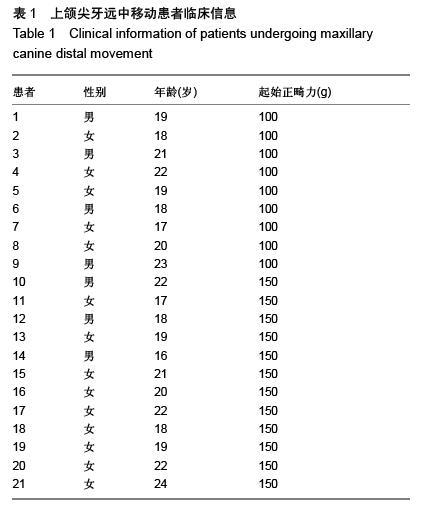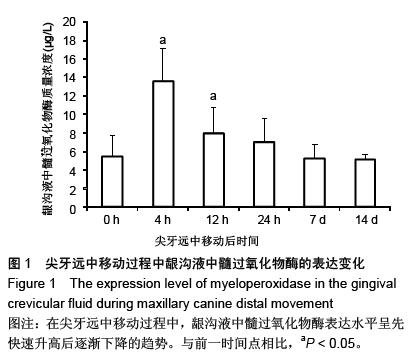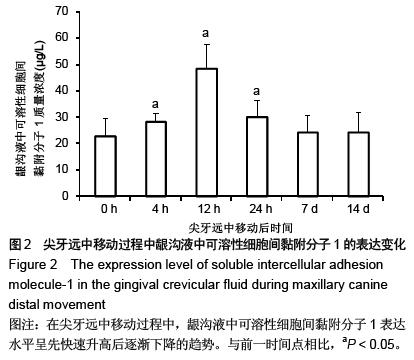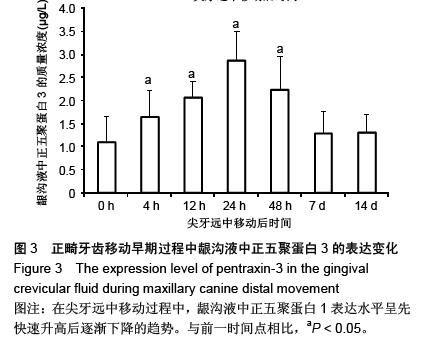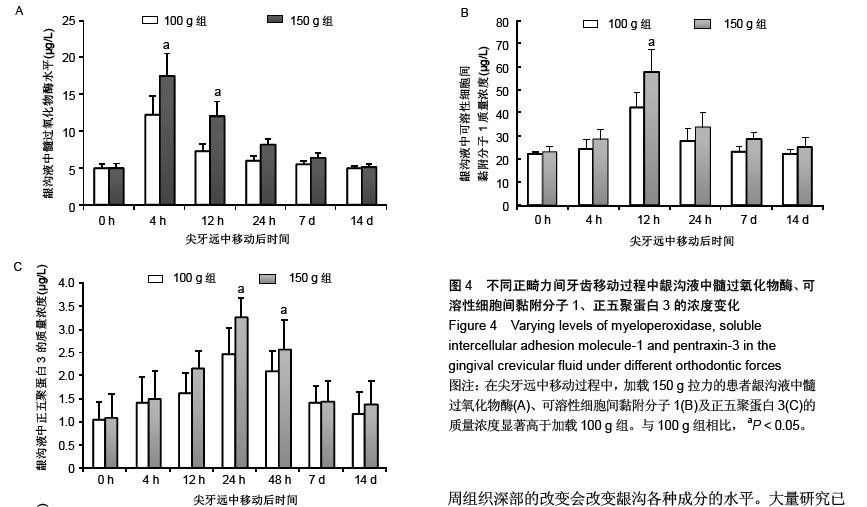中国组织工程研究 ›› 2016, Vol. 20 ›› Issue (2): 208-212.doi: 10.3969/j.issn.2095-4344.2016.02.010
• 口腔组织构建 oral tissue construction • 上一篇 下一篇
上颌尖牙远中移动过程中龈沟液内中性粒细胞浸润炎症相关因子的表达
许桓溪1,邢洪波2,苗 芳3,李 宁1,邱静怡4,李 娟4
- 1兰州石化总医院口腔科,甘肃省兰州市 730060;2威海市立医院口腔科,山东省威海市 264200;3兰州市口腔医院特诊科,甘肃省兰州市 730000;4四川大学华西口腔医院正畸科,口腔疾病研究国家重点实验室,四川省成都市 610041
Expression of myeloperoxidase, soluble intercellular adhesion molecule-1 and pentraxin-3 in the gingival crevicular fluid during maxillary canine distal movement
Xu Huan-xi1, Xing Hong-bo2, Miao Fang3, Li Ning1, Qiu Jing-yi4, Li Juan4
- 1Department of Stomatology, Shihua General Hospital of Lanzhou, Lanzhou 730060, Gansu Province, China; 2Department of Stomatology, Weihai Municipal Hospital, Weihai 264200, Shandong Province, China; 3Department of Special Consultation, Lanzhou Stomatology Hospital, Lanzhou 730000, Gansu Province, China; 4State Key Laboratory of Oral Diseases, Department of Orthodontics, West China Hospital of Stomatology, Sichuan University, Chengdu 610041, Sichuan Province, China
摘要:
文章快速阅读:
.jpg)
文题释义:
龈沟液:指通过沟内上皮和结合上皮从牙龈结缔组织渗入到龈沟内的液体。 牙龈健康者有极少量龈沟液,由组织内的渗透梯度而使组织液渗入龈沟内。龈沟液并非一种单纯的渗出液,通常有炎症细胞,其他化学成分与组织液也不完全相同,龈沟液的流出量与该部位的炎症程度成正比。
中性粒细胞:来源于骨髓,具有分叶形或杆状的核,胞浆内含有大量既不嗜碱也不嗜酸的中性细颗粒,这些颗粒多是溶酶体,内含髓过氧化酶、溶菌酶、碱性磷酸酶和酸性水解酶等丰富的酶类,与细胞的吞噬和消化功能有关。
背景:正畸牙齿移动过程早期,通过监测龈沟液中相关炎症因子的动态变化水平将有助于评估正畸早期效果,髓过氧化物酶、可溶性细胞间黏附分子1、正五聚蛋白3被证实与炎症密切相关,但当前对于正畸牙齿移动过程中的3种炎症因子的水平以及3种因子水平与正畸牙齿关系还不是十分清楚。
目的:通过检测上颌尖牙远中移动过程中不同时间段内龈沟液中髓过氧化物酶、可溶性细胞间黏附分子1、正五聚蛋白3的浓度,了解三者在在正畸治疗过程中的动态变化,探讨其与牙周炎症、尖牙移动距离以及正畸力间相关性。
方法:收集21例口腔正畸患者,按照正畸力值分为150 g组(n=12)和100 g组(n=9),分别加载150 g和100 g拉力。2组患者分别于牙齿正畸受力前、受力后4,12,24 h及7,14 d收集龈沟液,用ELISA试剂盒检测龈沟液内髓过氧化物酶,可溶性细胞间黏附分子1与正五聚蛋白3水平,分析三者在正畸牙齿移动早期的表达变化。
结果与结论:在尖牙远中移动早期,患者龈沟液中髓过氧化物酶的表达水平在正畸加力后显著上升,并于4 h达到峰值,后开始下降;而可溶性细胞间黏附分子1在正畸后12 h达到高峰后开始下降,二者在正畸力作用7 d后均恢复正常水平;正五聚蛋白3的表达水平在正畸加力后显著上升,于24 h达到峰值,后开始逐渐下降,同样于正畸治疗后7 d恢复正常水平;此外,加载150 g拉力的患者龈沟液中的髓过氧化物酶,可溶性细胞间黏附分子1与正五聚蛋白3的质量浓度显著高于加载100 g拉力的患者。提示在正畸牙齿移动早期过程中髓过氧化物酶、可溶性细胞间黏附分子1、正五聚蛋白3在龈沟液中呈现动态变化,三者可以有效的反映正畸力作用下牙周组织的炎症反应状况,对其水平的检测将有助于判断正畸力作用效果,预防不良反应发生。
ORCID: 0000-0002-8497-7980(李娟)
